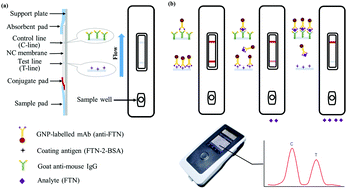Rapid quantitative determination of fentanyl in human urine and serum using a gold-based immunochromatographic strip sensor
Abstract
Fentanyl is a typical opioid that is used in surgical anesthesia. However, when abused, fentanyl can lead to addiction and even death. To better control the use of fentanyl, it is necessary to develop rapid and sensitive detection methods. In this study, an ultrasensitive monoclonal antibody (mAb) was prepared and used to develop an indirect competitive enzyme-linked immunosorbent assay (ic-ELISA) and a colloidal gold-based immunochromatographic strip (CG-ICS) for the analysis of fentanyl in urine and serum. Under optimum conditions, the anti-fentanyl mAb belonging to the subtype of IgG2b showed a half-maximal inhibitory concentration (IC50) of 0.11 ng mL−1 and a linear range of detection of 0.020–0.50 ng mL−1. Fenanyl-spiked original urine and serum diluted eight times were used for the analysis of fentanyl by ic-ELISA and CG-ICS. IC50 from the standard curves was 0.46 ng mL−1 for urine and 2.6 ng mL−1 for serum in ic-ELISA and 1.6 ng mL−1 for urine and 6.27 ng mL−1 for serum in CG-ICS. The recovery test revealed that the ic-ELISA and CG-ICS, with a recovery rate of 87.0–108.4% and a coefficient of variation of 3.3–10.9%, were the same reliable tools as the liquid chromatography tandem mass spectrometry for fentanyl analysis in real samples.



 Please wait while we load your content...
Please wait while we load your content...